ExpressView: Managing Data
Notice
This article applies to the ExpressView Designer in pre-v2021.1. For v2021.1+, refer to the ExpressView: Introduction (v2021.1+) article.
You can exercise some fine grained control over the actual data that appears in the ExpressView. You can choose styling options, you can filter down the rows to appear, and you can change the order of rows in their respective sections.
Formatting and Style
Formatting allows you to specify a data type (e.g. number, date, text) for specific data fields, and choose how that data displays.
To change the data type for a field:
- Click the Formatting and Style
 icon in the pane on the right to open the Formatting page.
icon in the pane on the right to open the Formatting page. - Click the data rows to format. They will highlight in blue.

Selecting data to format - In the pane on the right side of the screen, click the Data Formatheading to open it.
- From the Format Type list, select a data type from the following options:
General
Format the data using the default settings for your environment. The application will assume the data type.
Number
Format the data as a number.
- In the Decimal Places field, enter a number for how many decimal places to display. In the field to the right, enter a symbol to use as the decimal mark.
- To show a delimiter every three digits, select Use 1000 Separator. Then, in the field to the right, enter a symbol to use as the delimiter.
- To show a symbol before the number, indicating that this is currency, select Use Currency Symbol. Then, in the field to the right, enter the symbol to show.
- To show a percent sign after the number, indicating that this is a percentage, select Append Percent Sign.
- To show no value if the number is 0, select Blank When Zero.
- To show the negative symbol in front of negative numbers, select Show Negative Symbol.
- To show parentheses around negative numbers, select Show Parenthesis.
- To show negative numbers in a different color, select Color, then enter a hex value or use the color picker to choose a color.
Date
Format the data as a date, time, or date and time. You can choose which date and time components to display, and how to show them.

Choosing a date/time format Text
Do not apply any formatting to the data, and show it exactly as it appears in the database
If the data field cannot be formatted as a number or date, then selecting one of those options will have no effect on the appearance of the data.
Sorting
Sorting allows you to set the order that the data rows appear in each section. Click the Sorts  icon to open the list of sorts. Every data column in the ExpressView that is not a group column is automatically sorted.
icon to open the list of sorts. Every data column in the ExpressView that is not a group column is automatically sorted.
You can choose which columns take precedence for sorting. The order of fields on the Sorts page is their order of precedence, from highest to lowest. Their order is also indicated by a number on the right of the column headers: The lower the number, the higher the precedence.
To set the sort precedence of data fields, either:
- On the Sorts page, drag fields up or down.
- Use
 radial >down
radial >down  to give a field the highest precedence.
to give a field the highest precedence.

You can choose which direction to sort the data for each data field: ascending or descending. A field’s sort direction is indicated by an arrow on the right of the column header: Up  for ascending, down
for ascending, down  for descending.
for descending.
To change a field’s sort direction, either:
- On the Sorts page, select asc for ascending, or desc for descending.
- Click the column header to swap to the opposite direction.
Filtering
Filtering allows you to narrow the scope of your ExpressView by restricting the amount of data shown.
- Standard Filters allow only rows whose values satisfy certain conditions to appear in the report.
- Top N filters allow only the rows with the top or bottom values, for either data fields or data summaries, per group iteration to appear in the report.
Click the Filters  icon in the pane on the right side of the screen to open the list of filters. The filters page has two tabs: Standard and Top/Bottom.
icon in the pane on the right side of the screen to open the list of filters. The filters page has two tabs: Standard and Top/Bottom.
Standard Filters
To show only the data that satisfies several conditions:
- On the Filters page, click the Standard tab.
- To add a data field to filter, either:
- Use
 radial >right on a data column or group.
radial >right on a data column or group. - Drag a data field from the Data Pane on the left side of the screen to the Meet all of the following conditions pane.
Note
This allows you to filter any accessible data field, not just those on the ExpressView.
- Use
- Choose a filter operator from the list. See Filters for details.
- Enter a filter value or values by either
- Entering them directly with the keyboard
- Select them from the list of existing values. Type into the filter field to search for data values to filter.
- Click the Filter Function
 icon to choose a pre-defined value based on a formula programmed by the system administrator. (For example, First Day of Current Month or Friday of Last Week).
icon to choose a pre-defined value based on a formula programmed by the system administrator. (For example, First Day of Current Month or Friday of Last Week).
- Repeat steps 2-4 for every filter condition that the data must satisfy in order to show.
- If you are viewing live data, click Apply Changes to apply the filters.
To show only the data that satisfies at least one of several conditions:
- On the Filters page, click the Standard tab.
- To add a data field to filter, either:
- Use
 radial>right on a data column or group. Then drag the filter to the meet any of the following conditions pane.
radial>right on a data column or group. Then drag the filter to the meet any of the following conditions pane. - Drag a data field from the Data pane to the meet any of the following conditions pane.
Note
This allows you to filter any accessible data field, not just those on the ExpressView.
- Use
- Choose a filter operator from the list. See Filters for details.
- Enter a filter value or values, by either
- Entering them directly with the keyboard
- Select them from the list of existing values. Type into the filter field to search for data values to filter.
- Click the Filter Function
 icon to choose a pre-defined value based on a formula programmed by the system administrator. (For example, First Day of Current Month or Friday of Last Week).
icon to choose a pre-defined value based on a formula programmed by the system administrator. (For example, First Day of Current Month or Friday of Last Week).
- Repeat steps 2-4 for every filter condition, of which the data must satisfy at least one in order to show.
- If you are viewing live data, click Apply Changes to apply the filters.
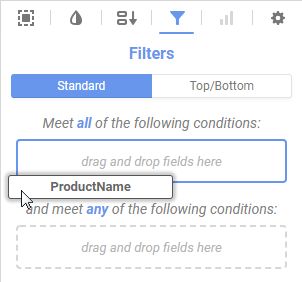
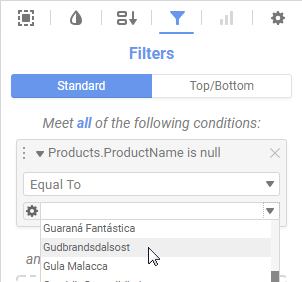
Top/Bottom Filters
To show only the top or bottom values, for either data fields or data summaries:
- On the Filters page, click the Top/Bottom tab.
- Select the Limit the report to the top/bottom values check box.
- Select either Top or Bottom, for whether you want to show the top or bottom values.
- Enter a number for how many values you want to show.
- Choose how you want to limit your data:
- If you want to show the rows with the top or bottom data values for a field or group, select Values from the list.
- If you want to show the groups with the top or bottom summary values for a parent group or the ExpressView, select one of the summary calculations, Sum, Avg, Min, Max, Count, or Distinct Count, from the list. See the article on aggregation for more information.
Note
Only numeric data fields support Sum and Avg calculations.
- Select the data field or group field to filter from the Of list.
- Optional: To show the top or bottom values for each iteration of a group:
- Click
 Add Group.
Add Group. - Select a group field from the For Each list.
- Click

 icon in the pane on the right to open the Formatting page.
icon in the pane on the right to open the Formatting page.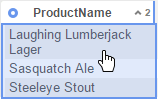
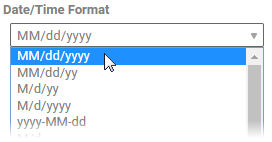
 radial >down
radial >down 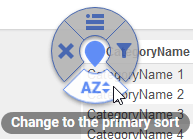 to give a field the highest precedence.
to give a field the highest precedence. icon to choose a pre-defined value based on a formula programmed by the system administrator. (For example, First Day of Current Month or Friday of Last Week).
icon to choose a pre-defined value based on a formula programmed by the system administrator. (For example, First Day of Current Month or Friday of Last Week). Add Group.
Add Group.